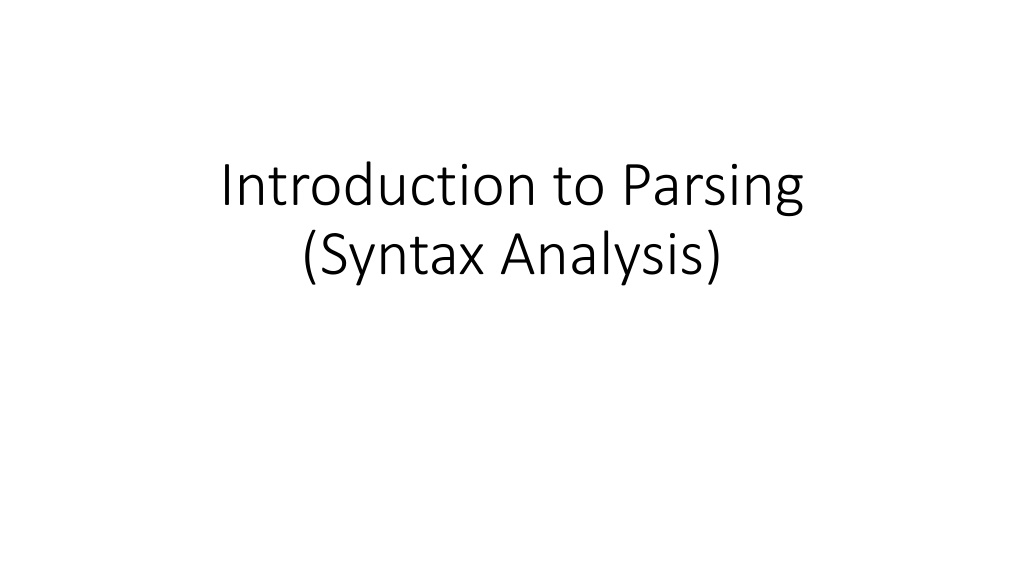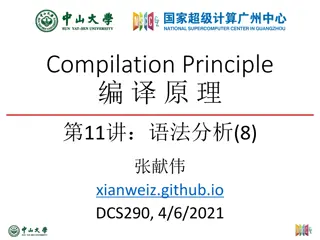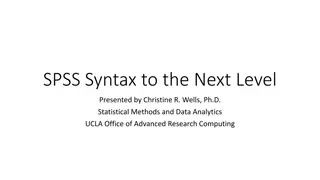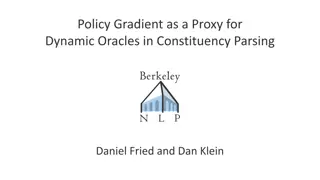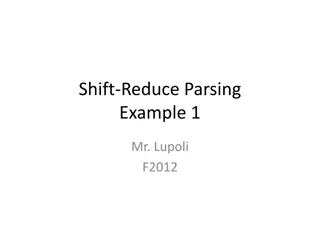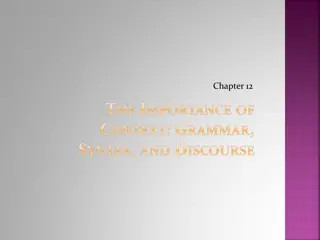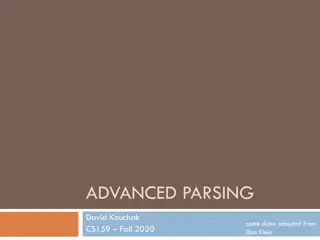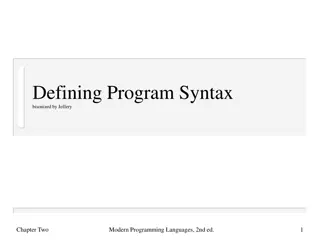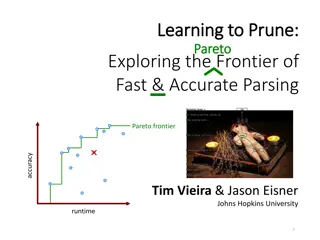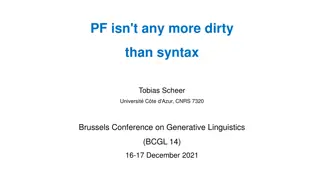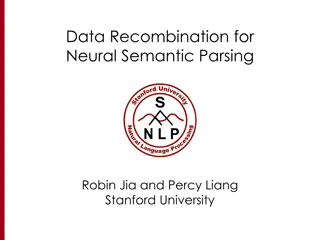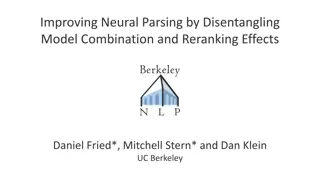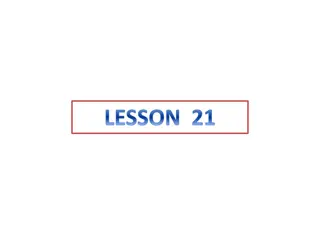Introduction to Parsing: Syntax Analysis
Parsing, or syntax analysis, is the process of analyzing input programs to determine if they are syntactically correct and valid in a given language. This involves lexical analysis, context-free grammars, derivations, parse trees, ambiguity parsing, regular expressions, and Chomsky's hierarchy of grammars. Understanding these concepts is essential for expressing context-free syntax using grammars and performing derivations and parsing in language processing.
Uploaded on Mar 01, 2025 | 0 Views
Download Presentation

Please find below an Image/Link to download the presentation.
The content on the website is provided AS IS for your information and personal use only. It may not be sold, licensed, or shared on other websites without obtaining consent from the author.If you encounter any issues during the download, it is possible that the publisher has removed the file from their server.
You are allowed to download the files provided on this website for personal or commercial use, subject to the condition that they are used lawfully. All files are the property of their respective owners.
The content on the website is provided AS IS for your information and personal use only. It may not be sold, licensed, or shared on other websites without obtaining consent from the author.
E N D
Presentation Transcript
Introduction to Parsing (Syntax Analysis)
Introduction Lexical Analysis: Reads characters of the input program and produces tokens. But: Are they syntactically correct? Are they valid sentences of the input language? Now: Context-free grammars, Derivations, Parse trees, Ambiguity Parsing: top-down and bottom-up.
Regular Expression The set of all strings of balanced parentheses {(), (()), ((())), }, The set of all 0s followed by an equal number of 1s, {01, 0011, 000111, ...}. Not all languages can be described by Regular Expressions!!
Chomskys hierarchy of Grammars: 1. Phrase structured. 2. Context Sensitive number of Left Hand Side Symbols number of Right Hand Side Symbols 3. Context-Free The Left Hand Side Symbol is a non-terminal 4. Regular Only rules of the form: A , A a, A pB are allowed. Regular Languages Context-Free Languages Cont.Sens.Ls Phr.Str.Ls
Expressing Syntax Context-free syntax is specified with a context-free grammar. A grammar, G, is a 4-tuple G={S,N,T,P}, where: S is a starting symbol; N is a set of non-terminal symbols; T is a set of terminal symbols; P is a set of production rules. Example: CatNoise CatNoise miau | miau rule 1 rule 2 We can use the CatNoise grammar to create sentences: E.g.: Rule Sentential Form - 1 CatNoise miau 2 CatNoise miau miau
Derivation and Parsing Such a sequence of rewrites is called a derivation The process of discovering a derivation for some sentence is called parsing!
Derivations Derivation: a sequence of derivation steps: At each step, we choose a non-terminal to replace. Different choices can lead to different derivations. Two derivations are of interest: Leftmost derivation: at each step, replace the leftmost non-terminal. Rightmost derivation: at each step, replace the rightmost non-terminal (we don t care about randomly-ordered derivations!)
A parse tree A parse tree is a graphical representation for a derivation that filters out the choice regarding the replacement order. catnoise catnoise miau Construction: start with the starting symbol (root of the tree); miau for each sentential form: add children nodes (for each symbol in the right-hand-side of the production rule that was applied) to the node corresponding to the left-hand-side symbol. The leaves of the tree (read from left to right) constitute a sentential form (fringe, or yield, or frontier, or ...)
Find leftmost derivation & parse tree for: x-2*y 1. Goal Expr 2. Expr Expr op Expr 3. | number 4. | id 5. Op + 6. | - 7. | * 8. | /
Find rightmost derivation & parse tree for: x-2*y 1. Goal Expr 2. Expr Expr op Expr 3. | number 4. | id 5. Op + 6. | - 7. | * 8. | /
Derivations and Precedence The leftmost and the rightmost derivation in the previous slide give rise to different parse trees. Assuming a standard way of traversing: The former will evaluate to x (2*y). The latter will evaluate to (x 2)*y. The two derivations point out a problem with the grammar: it has no notion of precedence (or implied order of evaluation). To add precedence: force parser to recognise high- precedence sub-expressions first.
Ambiguity A grammar that produces more than one parse tree for some sentence is ambiguous. Or: If a grammar has more than one leftmost derivation for a single sentential form, the grammar is ambiguous. If a grammar has more than one rightmost derivation for a single sentential form, the grammar is ambiguous.
Ambiguity Example: Stmt if Expr then Stmt | if Expr then Stmt else Stmt | other What are the derivations of: if E1 then if E2 then S1 else S2
Eliminating Ambiguity Rewrite the grammar to avoid the problem Match each else to innermost unmatched if: 1. Stmt IfwithElse 2. | IfnoElse 3. IfwithElse if Expr then IfwithElse else IfwithElse 4. | other stmts 5. IfnoElse if Expr then Stmt 6. | if Expr then IfwithElse else IfnoElse if E1 then if E2 then S1 else S2
Eliminating Ambiguity Rewrite the grammar to avoid the problem Match each else to innermost unmatched if: 1. Stmt IfwithElse 2. | IfnoElse 3. IfwithElse if Expr then IfwithElse else IfwithElse 4. | other stmts 5. IfnoElse if Expr then Stmt 6. | if Expr then IfwithElse else IfnoElse if E1 then if E2 then S1 else S2 (2) (5) (?) (1) (3) (?) (4) (4) Stmt IfnoElse if Expr then Stmt if E1 then Stmt if E1 then IfwithElse if E1 then if Expr then IfwithElse else IfwithElse if E1 then if E2 then IfwithElse else IfwithElse if E1 then if E2 then S1 else IfwithElse if E1 then if E2 then S1 else S2
Deeper Ambiguity Ambiguity usually refers to confusion in the CFG Overloading can create deeper ambiguity E.g.: a=b(3) : b could be either a function or a variable. Disambiguating this one requires context: An issue of type, not context-free syntax Needs values of declarations Requires an extra-grammatical solution Resolving ambiguity: if context-free: rewrite the grammar context-sensitive ambiguity: check with other means: needs knowledge of types, declarations, This is a language design problem Sometimes the compiler writer accepts an ambiguous grammar: parsing techniques may do the right thing .
Parsing techniques Top-down parsers: Construct the top node of the tree and then the rest in pre- order. (depth-first) Pick a production & try to match the input; if you fail, backtrack. Essentially, we try to find a leftmost derivation for the input string (which we scan left-to-right). some grammars are backtrack-free (predictive parsing). Bottom-up parsers: Construct the tree for an input string, beginning at the leaves and working up towards the top (root). Bottom-up parsing, using left-to-right scan of the input, tries to construct a rightmost derivation in reverse. Handle a large class of grammars.
Top-down vs Has an analogy with two special cases of depth-first traversals: Pre-order: first traverse node x and then x s subtrees in left- to-right order. (action is done when we first visit a node) Post-order: first traverse node x s subtrees in left-to-right order and then node x. (action is done just before we leave a node for the last time) bottom-up! Expr id * id Expr * id Expr op id Expr op Expr Expr op id Expr * id Expr Expr op Expr id * id
Top-Down Parsing Next Class
